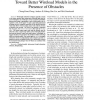Free Online Productivity Tools
i2Speak
i2Symbol
i2OCR
iTex2Img
iWeb2Print
iWeb2Shot
i2Type
iPdf2Split
iPdf2Merge
i2Bopomofo
i2Arabic
i2Style
i2Image
i2PDF
iLatex2Rtf
Sci2ools
ASPDAC
2001
ACM
2001
ACM
Toward better wireload models in the presence of obstacles
Wirelength estimation techniques typically contain a site density function that enumerates all possible path sites for each wirelength in an architecture and an occupation probability function that assigns a probability to each of these paths to be occupied by a wire. In this paper we apply a generating polynomial technique to derive complete expressions for site density functions which take effects of layout region aspect ratio and the presence of obstacles into account. The effect of an obstacle is separated into two parts: the terminal redistribution effect and the blockage effect. The layout region aspect ratio and the obstacle area are observed to have a much larger effect on the wirelength distribution than the obstacle's aspect ratio and location. Accordingly, we suggest that these two parameters be included as indices of lookup tables in wireload models. Our results apply to a priori wirelength estimation schemes in chip planning tools to improve parasitic estimation accur...
| Added | 23 Aug 2010 |
| Updated | 23 Aug 2010 |
| Type | Conference |
| Year | 2001 |
| Where | ASPDAC |
| Authors | Chung-Kuan Cheng, Andrew B. Kahng, Bao Liu, Dirk Stroobandt |
Comments (0)

